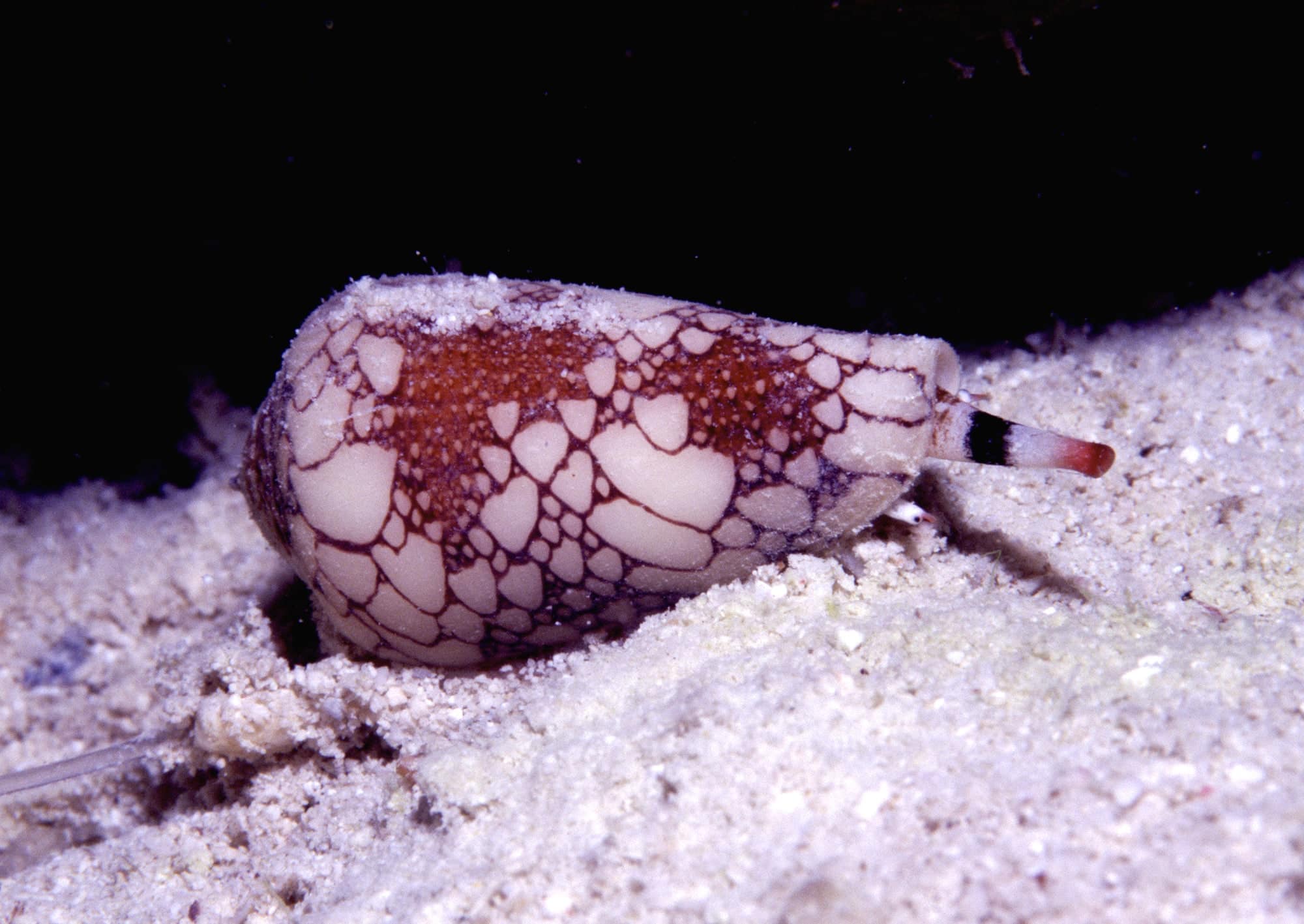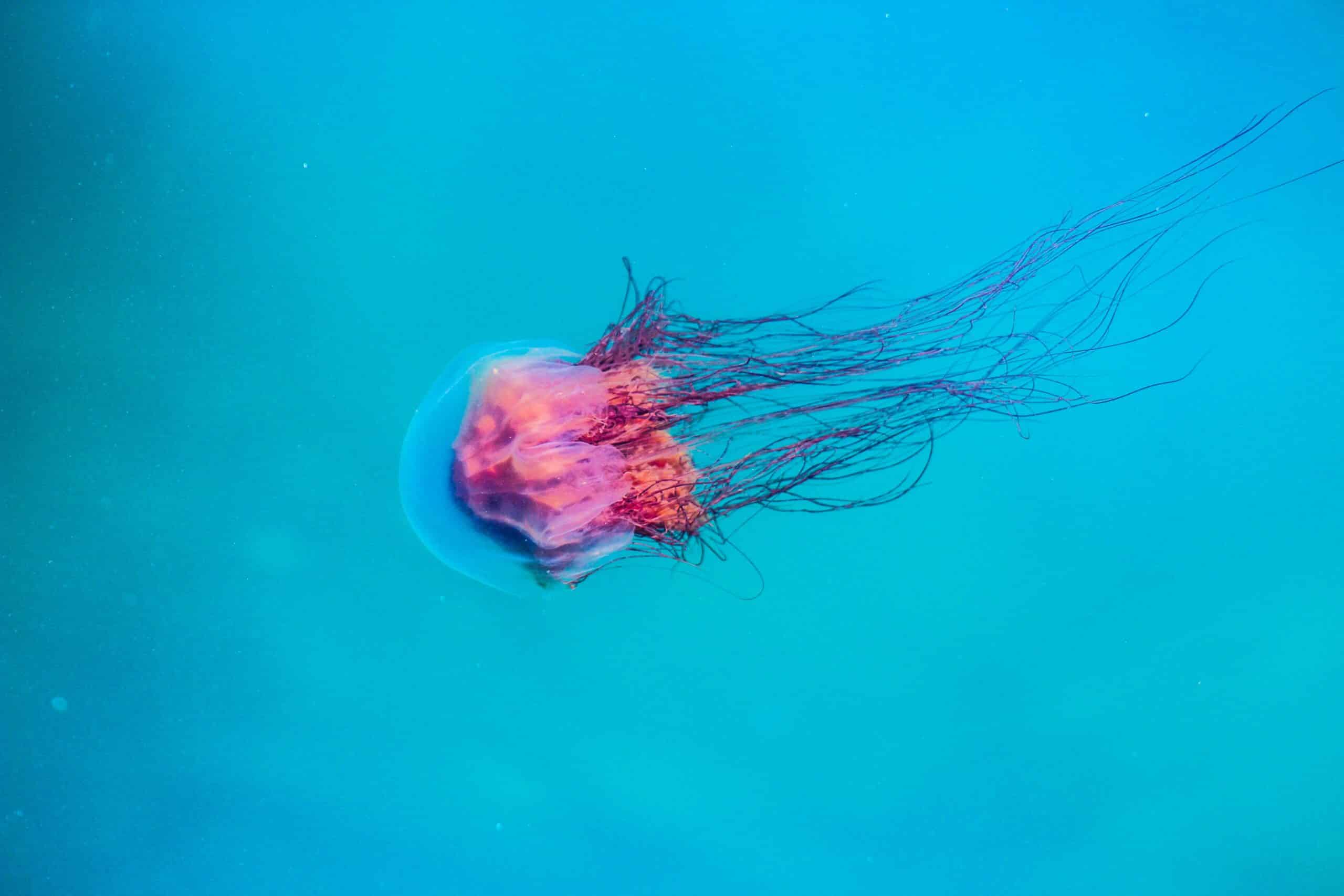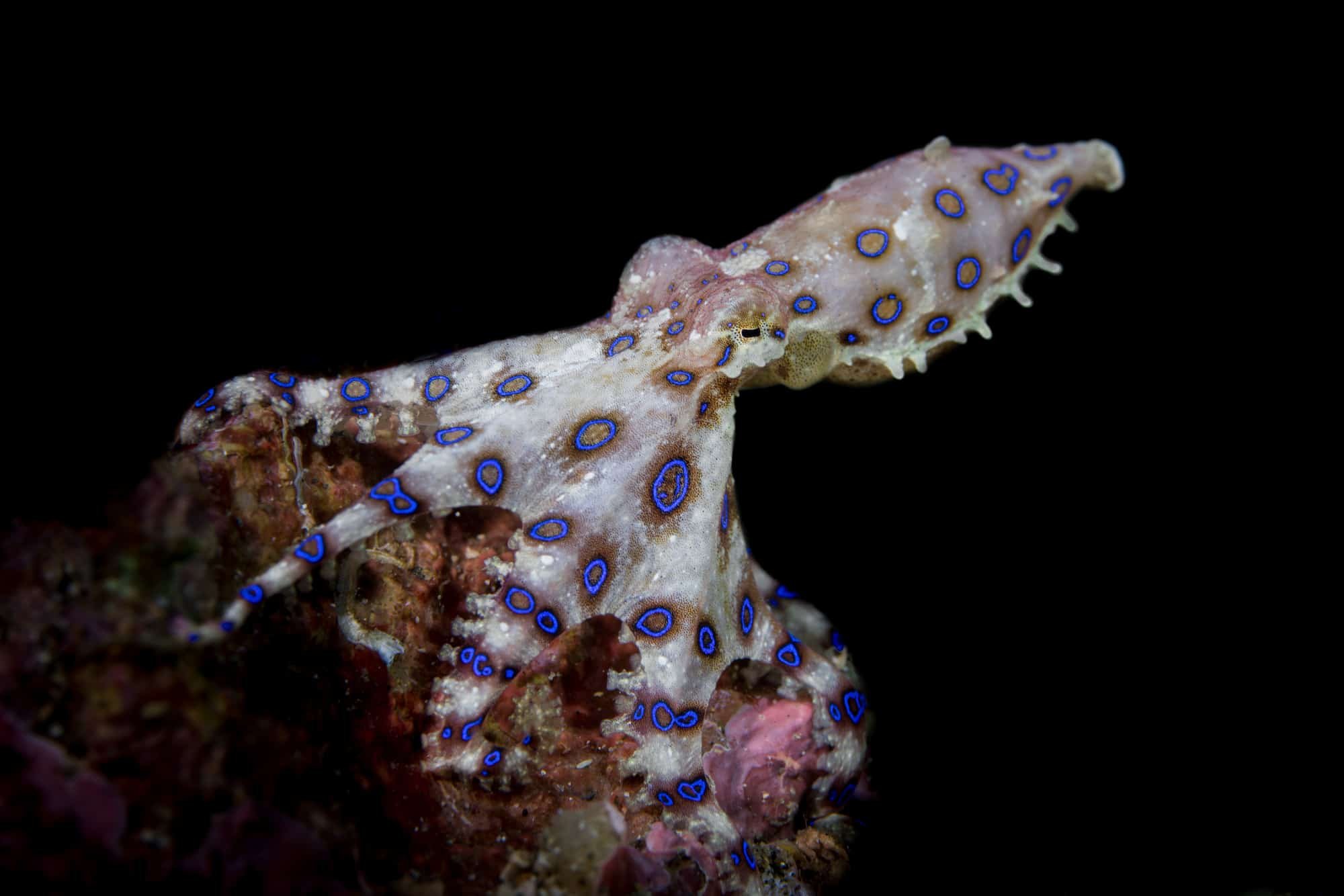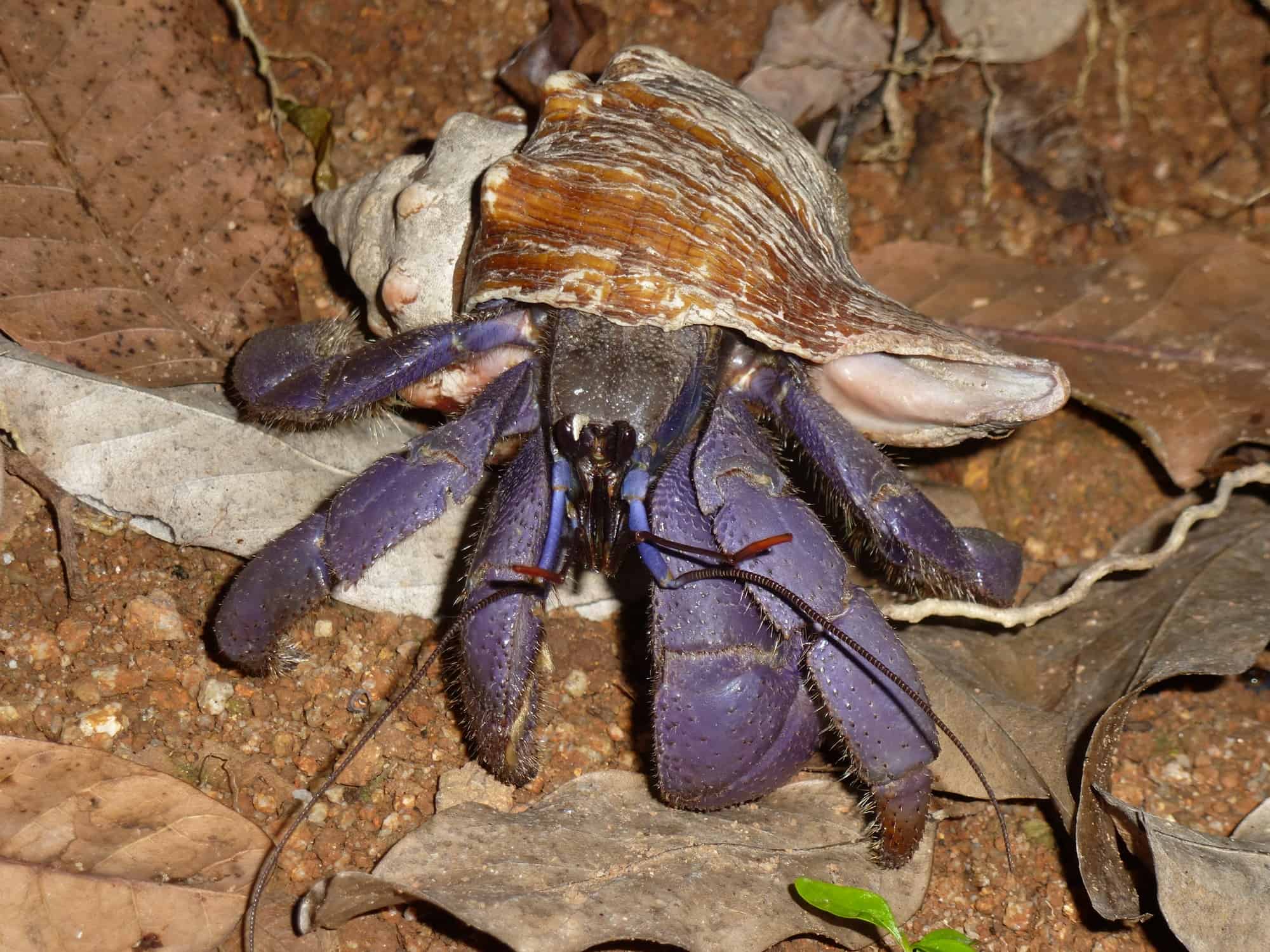Nature is full of remarkable phenomena, but few are as astonishing as the ability to regenerate lost or damaged body parts. While starfish regrow their arms and lizards regrow their tails, a particular animal is astounding scientists worldwide because it can regenerate something much more complex: its brain. Let’s delve into this fascinating and perplexing …
Invertebrates
Welcome to the articles on Invertebrates.
As a wildlife journalist, I’ve been fortunate enough to witness the staggering diversity of life on our planet. I’ve tracked tigers in the thick forests of India, watched in awe as elephants roamed the African savannah, and marveled at the flight of eagles in North America.
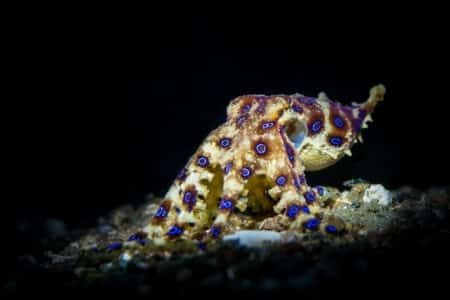
Blue-ringed Octopus (Hapalochlaena sp.) resting on sand in the Lembeh Strait / Sulawesi / Indonesia
However, today, I want to take a step back from these majestic vertebrates and shift our focus to a group of creatures often overlooked despite their incredible importance – the invertebrates.
Best Invertebrates Articles
- This Animal Can Regrow Its Entire Brain – Scientists Are Stunned!
- A Lethal Invertebrate: The Cone Snail Bite
- The Secret of Animals That Can Breathe Through Their Skin
- The Largest Octopus Ever Recorded Off the Coast of Washington
- Discover the World’s Largest Land Snail
- Deadly Beauties: The World’s Most Lethal Jellyfish
- What Makes the Leafy Sea Dragon a Master of Disguise
- The Giant Squid A Mysterious Colossal Sea Creature
- Are Lobsters Food or Sentient Beings? The Heated Debate
- The Secret Behind Starfish Regrowing Limbs
- How Sea Cucumbers Defend Themselves by Ejecting Organs
- Exploring the Mysteries and Dangers of the Blue-Ringed Octopus
- Why Cuttlefish Flash Colors to Communicate and Confuse Prey
- US States Safe From The Arizona Bark Scorpion
- Why Coral Reefs Are Dying and What’s Being Done to Stop It
- The Slow and Graceful Movement of the Giant Clam
- Why the Slug Is One of the Slowest Creatures on Earth
- World’s Largest Crab (9 lb) Climbs Trees
- The Animal That Can Survive in Outer Space
- Why We’re Only Just Understanding Animal Memory
- Could Octopuses Be More Conscious Than We Think?
- The Box Jellyfish The Most Venomous Animal in the Sea
- What Happens If Coral Bleaching Reaches 100%?
- How the Garden Snail is One of the Slowest Creatures on Earth
- How Octopuses Outsmart Predators Using Disguises
- The Starfish A Sea Creature That Takes Its Time
- How Earthworms Help Your Garden Thrive
- 13 Deep Sea Animals That Can Survive Crushing Pressure
- The Most Aggressive Crabs Storming U.S. Beaches
- Why Octopuses Are Smarter Than We Thought
- Could Marine Life Survive Without Coral Reefs?
- An Entire Ecosystem Was Found in a Single Raindrop
- The Mantis Shrimp An Ocean Creature with a Sound Like a Gunshot
- The Mantis Shrimp An Underwater Hunter Without a Sound
- Why the Garden Snail Moves at a Glacial Pace
- The Deadly Sting of the Box Jellyfish A Silent Predator
- The Oldest Coral Reef Ever Found in U.S. Territory
- 15 Animals that Survive with no Physical Brain
- The Most Enormous Lobster Ever Pulled From Maine Waters
- 10 Most Elusive Sea Creatures in the Gulf of Mexico
- The Most Camouflaged Creature Lurking in Pacific Waters
- The Worlds Most Dangerous Jellyfish Is Spreading Here is Why
- Why Crabs Are Marching Across U.S. Coastal Towns
- How an Octopus Can Disappear in Less Than a Second
- U.S. Scientists Map the Brain of an Octopus
- The Only Creature That Can Survive Boiling, Freezing, and Outer Space
- The Most Poisonous Jellyfish Ever Discovered And How It Kills
- The Only Animal That Can Survive in Space Without a Spacesuit
- This Animal Can Live in Outer Space
- This Worm Can Live in Boiling Acid
- The Secret of the Sea Cucumber’s Survival Trick
- The Only Animal That Can Regrow Its Brain
- The Most Vibrant Coral Reef Ever Found in U.S. Waters
- The Delicate Balance of Coral Reef Ecosystems and the Role of Titan Triggerfish
The Silent Majority

Animals without backbones, make up a staggering 97% of all animal species on Earth. This group includes everything from the tiniest insects to the magnificent octopus, from delicate butterflies to the formidable great white shark.
They inhabit every corner of the world, from the darkest depths of our oceans to the highest peaks of our mountains.
Invertebrates: Architects of Ecosystems
Invertebrates play a crucial role in maintaining our ecosystems. They are the unsung heroes of biodiversity, often invisible but vital to the health of our planet. Earthworms, for example, aerate the soil and aid in decomposition, contributing to nutrient cycling.
Bees and butterflies are essential pollinators, their work ensuring the survival of many plant species and, by extension, the survival of countless other animals that depend on those plants.
The Fascinating World of Invertebrates
Despite their small size, invertebrates lead complex and fascinating lives. Take the octopus, for instance. This intelligent cephalopod is known for its problem-solving abilities and use of tools, traits once thought exclusive to vertebrates.
In the insect world, we have the leafcutter ants, which maintain complex fungal gardens inside their colonies, a remarkable example of agriculture outside the human world.
Threats Facing Invertebrates
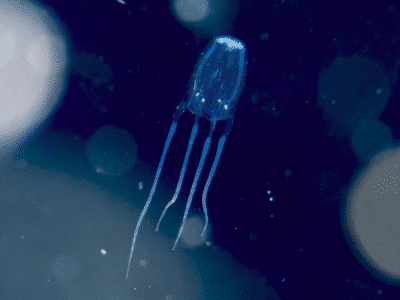
Despite their importance, invertebrates face numerous threats. Habitat destruction, climate change, pollution, and overexploitation are all factors contributing to the decline of invertebrate populations worldwide.
The plight of bees, which have seen drastic population declines in recent years, is a poignant example of the challenges facing these creatures.
The Crucial Role of Conservation

Protecting invertebrates is not just about saving individual species; it’s about preserving the very fabric of our ecosystems. Many conservation organizations are already working hard to protect invertebrates, from establishing pollinator-friendly habitats to conducting research on invertebrate populations.
But there is still much work to be done, and everyone can play a part, whether it’s planting a pollinator garden or reducing pesticide use.
Conclusion
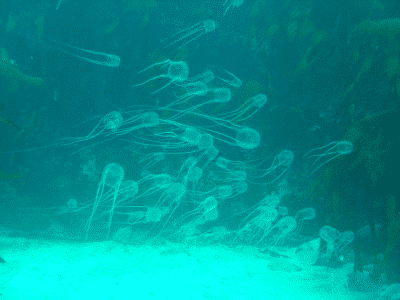
Invertebrates may be small, but their impact is enormous. As we continue to grapple with environmental issues, it’s more important than ever to recognize the vital role these creatures play in our world.
Let’s celebrate invertebrates not just for their inherent worth, but also for their essential contributions to our ecosystems. It’s high time we give these unsung heroes the attention and protection they so richly deserve.
It’s time for us to stop overlooking the invertebrates and start appreciating their indispensable contribution to our planet’s biodiversity.
The Cone Snail sports a beautiful shell, but also contains a lethal bite – here’s all you need to know in case you get bitten or stung by one. The cone snails exhibit extraordinary adaptations and behaviors that make them fascinating invertebrates. These marine snails have beautiful and intricate shells, which are highly sought after …
Within diversity of animal life on our planet, some creatures have evolved remarkable adaptations that seem almost magical to human observers. Among these fascinating evolutionary marvels is cutaneous respiration—the ability to breathe through skin. While humans and many other mammals rely exclusively on lungs for gas exchange, numerous animals can supplement or even completely replace …
Off the Pacific coastline lies the remarkable and expansive realm of the octopus. Among these fascinating creatures, the largest ever recorded was discovered off the coast of Washington. This article delves into the world of this extraordinary giant, offering intriguing insights into its biology, behavior, and the environment it calls home. The Giant of the …
The world’s largest land snail on our planet is the astounding African Giant Snail. The African giant snail, scientifically known as Achatina fulica, is a remarkable gastropod mollusk that hails from East Africa. With its impressive size and distinctive shell, this snail species has become renowned for its voracious appetite and remarkable adaptability. Get ready …
Are you curious which jellyfish species are the most deadly and dangerous in the world? You may be surprised that various types of jellyfish can have potentially life-threatening effects. Let’s explore some of the most lethal species of jellyfish on our planet and delve into their fascinating characteristics. Learn why these creatures are so dangerous, …
In the cool waters off southern Australia, one of nature’s most extraordinary masters of disguise silently drifts with the currents. The leafy sea dragon (Phycodurus eques) represents one of evolution’s most remarkable achievements in camouflage. Unlike most marine creatures that hide or flee from predators, the leafy sea dragon has developed an appearance so perfectly …
The ocean is shrouded in mystery, with its depths housing creatures beyond our wildest imagination. Among the most enigmatic of these inhabitants is the giant squid, a colossal being that has inspired maritime legends and scientific intrigue alike. This article delves into the world of the giant squid, uncovering fascinating facts about this elusive sea …
In restaurants across the world, lobsters are often boiled alive before being served as a delicacy. This practice has existed for centuries, with lobster meat considered a luxurious treat by many. Yet in recent years, a profound ethical question has emerged: Are lobsters merely seafood, or are they sentient beings capable of experiencing pain and …
Starfish, also known as sea stars, possess one of the animal kingdom’s most extraordinary abilities—they can regrow entire limbs after injury. This remarkable regenerative capability has fascinated scientists for centuries and continues to be the subject of intensive research today. Unlike humans, who can heal wounds but cannot regrow entire appendages, starfish can restore complex …
Sea cucumbers are remarkable marine creatures that have developed one of the most unusual defense mechanisms in the animal kingdom. When threatened, these seemingly vulnerable echinoderms can perform an astonishing feat: they eject their internal organs at predators in a process called evisceration. This startling defense strategy not only deters attackers but also showcases the …
This tiny creature, the Blue-Ringed Octopus measuring only a few inches long, packs a powerful punch with its venomous saliva, which can kill a human within minutes. Without prompt treatment, it can lead to death within hours of the bite. Immediate care should include CPR and artificial respiration until professional medical help arrives. The Blue-ringed …
In the mysterious depths of our oceans lives one of nature’s most extraordinary visual artists—the cuttlefish. These remarkable cephalopods possess an unparalleled ability to transform their appearance in milliseconds, producing dazzling displays of colors, patterns, and textures that seem almost magical to human observers. Unlike chameleons, which are often incorrectly cited as the animal kingdom’s …
The Arizona bark scorpion, scientifically known as *Centruroides sculpturatus*, is one of the most infamous arachnids in the southwestern United States. Noted for its slender body, poisonous sting, and tan color, this scorpion has permeated popular imagination, often eliciting fear and fascination. But beyond the myths and the media hype, it is a creature integral …
Beneath the ocean’s surface lies one of Earth’s most spectacular and vital ecosystems – coral reefs. Often called “rainforests of the sea,” these vibrant underwater structures support approximately 25% of all marine species while covering less than 1% of the ocean floor. Yet today, these magnificent ecosystems face an unprecedented crisis. From the Great Barrier …
The ocean is home to a myriad of fascinating creatures, each bringing its unique characteristics to the marine ecosystem. Among these, the giant clam stands out, not only due to its impressive size but also because of its slow and graceful movements. Giant clams are members of the Tridacninae subfamily, known for their vibrant colors …
When it comes to the animal kingdom, there are a few species known for their lack of speed, and top among them is the humble slug. Often portrayed as one of the slowest creatures on Earth, slugs have a pace that might seem unremarkable to us. However, their sluggish speed is a fascinating result of …
Meet the largest land-dwelling anthropoid: the coconut crab. This unique creature has developed some remarkable features and adaptations to survive in its terrestrial environment. It’s a genuinely fascinating species; still, few people are familiar with it. Introduction From its peculiar anatomy to its extraordinary abilities to its unusual social behaviors, there are mountains of exciting …
In the vast emptiness of space, where temperatures fluctuate between extreme cold and scorching heat, where radiation is abundant, and where there’s no oxygen or atmospheric pressure, life as we know it cannot survive. Yet, against all odds, there exists one remarkable creature that defies these harsh conditions: the tardigrade, also known as the water …
For centuries, humans believed we were uniquely gifted with complex memory systems, while animals operated primarily on instinct with limited capacity to remember past events or plan for the future. This anthropocentric view has been dramatically overturned in recent decades as revolutionary research techniques have unveiled sophisticated memory capabilities across the animal kingdom. From elephants …
In the shadowy depths of the ocean, one of Earth’s most enigmatic minds is at work. The octopus—with its eight arms, three hearts, and distributed nervous system—has long fascinated scientists and casual observers alike. But recent research has begun to suggest something even more profound: these cephalopods may possess levels of consciousness far beyond what …
The box jellyfish is often regarded as one of the most venomous creatures inhabiting the world’s oceans. Belonging to the class Cubozoa, these gelatinous sea creatures have captivated the attention of marine biologists and enthusiasts alike. Their cube-shaped, transparent bodies house tentacles loaded with potent venom, which are a testament to the evolutionary adaptations that …
Coral reefs, often called the rainforests of the sea, are among Earth’s most valuable ecosystems. They occupy less than 1% of the ocean floor yet support approximately 25% of all marine species. However, these vibrant underwater worlds face an existential threat: coral bleaching. As global temperatures rise and ocean conditions deteriorate, scientists are increasingly concerned …
The garden snail, scientifically recognized as Cornu aspersum, is a small terrestrial gastropod that has quietly captivated the interest of biologists and nature enthusiasts alike. Known for its strikingly slow pace, this tiny creature stands as one of the slowest movers in the animal kingdom. Though often seen as a common pest in gardens, the …
In the vast underwater world, where survival often depends on outsmarting others, octopuses stand as unrivaled masters of disguise. These remarkable cephalopods possess an extraordinary arsenal of deceptive techniques that have evolved over millions of years, allowing them to evade predators in some of the most ingenious ways nature has ever devised. Unlike many marine …
The starfish, often referred to as the sea star, commands attention in the vibrant underwater world with its unique shape and vibrant colors. This intriguing sea creature, known for its leisurely lifestyle, has a fascinating biology and role in marine ecosystems. Despite its name, the starfish isn’t a fish. It belongs to a group called …
Gardening enthusiasts constantly seek natural ways to nurture their green spaces without relying on synthetic fertilizers and pesticides. While there are numerous organic solutions available, the humble earthworm often goes overlooked. Despite their unassuming nature and subterranean lifestyle, earthworms are amongst the most effective allies you can have for a thriving garden. Their contributions to …
The mysteries of the deep sea are as captivating as they are perplexing. In the impenetrable depths of our oceans, incredible creatures thrive under conditions that would crush human life. These hardy inhabitants of the abyss have adapted to survive in one of the most extreme environments on earth, where pressures can reach more than …
The United States is home to a vast array of marine life, with its beaches hosting a diverse ecosystem of creatures. However, a new wave of aggressive crabs is making its presence known on the sandy shores, surprising beachgoers and scientists alike. This article dives into the background, behavior, and ecological impact of these crustacean …
Deep beneath the ocean’s surface, a revolution in our understanding of intelligence is unfolding. Octopuses, with their alien-like appearance and remarkable problem-solving abilities, are challenging long-held assumptions about the nature and evolution of intelligence. These eight-armed invertebrates, despite having evolved along a completely separate evolutionary path from vertebrates like mammals and birds for over 550 …
Coral reefs are often called the rainforests of the sea, and for good reason. These complex underwater ecosystems support approximately 25% of all marine species while covering less than 1% of the ocean floor. The intricate relationship between coral reefs and marine biodiversity raises a critical question in our era of climate change and environmental …
In a remarkable discovery that challenges our perception of microscopic worlds, scientists have identified an entire functioning ecosystem within the confines of a single raindrop. This extraordinary finding reveals how even the smallest volumes of water can harbor complex communities of microorganisms, showcasing nature’s efficiency in creating interconnected life systems regardless of scale. The raindrop …
The mantis shrimp, despite its name, is not a shrimp. This vibrant ocean creature belongs to the order Stomatopoda and is renowned for its striking appearance and incredible abilities. Found predominantly in tropical and subtropical waters, mantis shrimp are often celebrated for their vibrant colors, advanced eyesight, and unique hunting tactics. However, one of the …
The mantis shrimp is a marine crustacean that captivates scientists and animal enthusiasts alike with its extraordinary abilities. With its brilliant colors and remarkable hunting skills, this creature is a true marvel of the underwater world. Despite its name, the mantis shrimp is neither a mantis nor a shrimp; its unique characteristics set it apart …
The garden snail, known scientifically as Cornu aspersum, is often cited as an example of sluggishness. Despite its seemingly inconsequential pace, its unique adaptation strategies have helped it survive and thrive in its natural habitat. Understanding why the garden snail moves so slowly can provide deeper insights into its physiology, survival mechanisms, and role in …
The ocean is a realm of wonder and mystery, teeming with creatures as fascinating as they are formidable. Among these, the box jellyfish stands out not only for its unusual shape but for its potent sting. This silent predator is known for its deadly venom and can be found in the waters of the Indo-Pacific …
Coral reefs are often celebrated as the rainforests of the sea due to their vivid beauty and biodiversity. These underwater ecosystems support a wealth of marine life and provide critical resources for human communities around the world. Among the many coral reefs gracing the oceans, one stands out for its remarkable age and historical significance. …
In the fascinating world of biological science, the brain is often viewed as the indispensable organ for controlling and coordinating an organism’s functions. Yet, nature never ceases to amaze us. There exists a unique group of animals that defy this conventional understanding. These creatures have no physical brain as we know it, but they still …
The chilly waters off the coast of Maine are a prime location renowned for yielding some of the finest lobsters in the world, but every once in a while, these waters offer up a catch so extraordinary that it captures the imagination of seafood enthusiasts and the broader public alike. One such marvel is the …
The Gulf of Mexico is a mysterious underwater realm teeming with life. However, some of its inhabitants remain shrouded in mystery, rarely seen by human eyes. These elusive sea creatures captivate the imagination of marine biologists, divers, and ocean enthusiasts alike. Their rare appearances and unique adaptations make them some of the most intriguing species …
The Pacific Ocean is a vast and mysterious expanse, teeming with life forms both known and yet to be discovered. Within its depths, some of the most intriguing and elusive creatures use camouflage as a survival tactic. Among them, the mimic octopus stands as a master of disguise, bewildering predators and researchers alike with its …
The oceans are full of mysteries and wonders, but not all of their inhabitants are benign. Among these remarkable creatures is the box jellyfish, often recognized as the most dangerous jellyfish in the world. Known for its venomous sting, this marine animal is now spreading to regions previously unaffected by its presence. This article delves …
The sight of thousands of crabs marching across U.S. coastal towns may seem like a scene straight out of a sci-fi movie, but it is, in fact, a reality for many seaside communities. This fascinating phenomenon raises questions about the natural world and our environmental impact. In this article, we delve into the reasons behind …
The ocean is teeming with marvels, yet few are as captivating as the octopus. Renowned for their intelligence and ability to vanish in the blink of an eye, these cephalopods have piqued the interest of both scientists and enthusiasts alike. This disappearing act, mastered over millions of years of evolution, is not only a testament …
In a groundbreaking scientific achievement, researchers from several prestigious U.S. institutions have successfully created the first comprehensive map of an octopus brain. This milestone represents a significant advancement in our understanding of cephalopod neurology and raises fascinating questions about the evolution of intelligence across different branches of the animal kingdom. The octopus, with its remarkable …
In the vast diversity of life on Earth, one remarkable creature stands out for its extraordinary ability to endure the most extreme conditions: the tardigrade. Often referred to as ‘water bears’ or ‘moss piglets,’ these microscopic animals are virtually indestructible. Tardigrades have fascinated scientists and the general public alike with their astounding resilience, which allows …
The ocean is a vast and mysterious realm, hiding creatures that are as beautiful as they are deadly. Among these enigmatic beings, the jellyfish stands out, with its delicate form concealing a potent threat. While many jellyfish are relatively harmless, there exists a select few whose sting can be lethal. Let’s dive into the world …
When it comes to surviving extreme conditions, one tiny creature reigns supreme. This remarkable organism can withstand temperatures that would freeze or boil most life forms, endure crushing pressures, and even survive the vacuum of space—all without the help of any protective gear or spacesuit. This article delves into the fascinating world of the tardigrade, …
In the vast, inhospitable vacuum of space, where temperatures fluctuate between extreme cold and scorching heat, radiation is abundant, and there’s no oxygen to breathe, life as we know it cannot survive. Yet, against all odds, scientists have discovered an extraordinary creature that defies these limitations. The water bear, or tardigrade, stands as perhaps the …
In the most extreme environments on Earth, where life seems impossible, certain organisms not only survive but thrive. Among these remarkable creatures is the Pompeii worm (Alvinella pompejana), an extraordinary deep-sea extremophile that can withstand conditions that would instantly kill most other living beings. This remarkable creature lives near hydrothermal vents on the ocean floor, …


